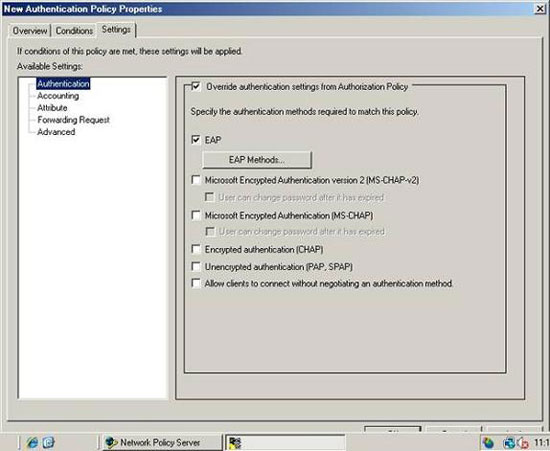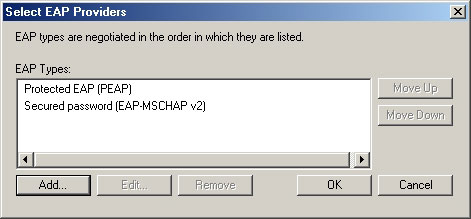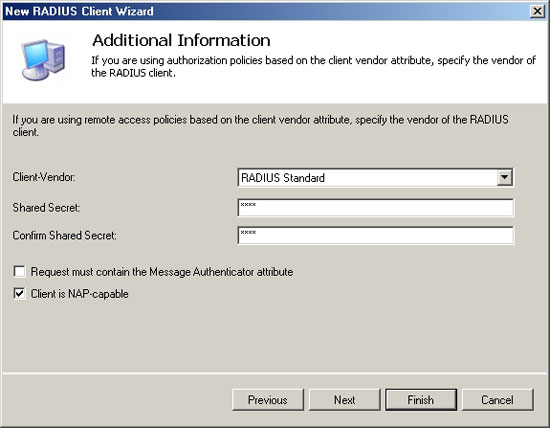Introduction to Network Access Protection (Part 6)
Introduction to Network Access Protection (Part 1)
Introduction to Network Access Protection (Part 2)
Introduction to Network Access Protection (Part 3)
Introduction to Network Access Protection (Part 4)
Introduction to Network Access Protection (Part 5)
In the previous articles, I have shown you how to create an authentication policy for both the computer to be checked and without checking. In this article, we will continue the server configuration procedure. The first step in this is to create a default authentication policy that can be applied to any computer that is authenticated through the RRAS server.
Start the process by opening the Network Policy Server window and entering NPS (Local) | Authentication Processing | Authentication Policies. Once entered here, the details window must display any pre-existing audit policies. Delete existing policies by clicking on them and selecting the Delete command from the right-click menu.
Now we create a default authentication policy. To do this, click on the New link in the Actions window, then select the Custom option. Windows will show you the New Authentication Policy properties window as shown in Figure A.

Figure A : Enter RRAS as a policy name and then verify that policy is enabled
Enter RRAS as a policy name and then verify the selected Policy Enabled check box. Next, make sure the Available Sources button is also selected, then select the Remote Access Server (VPN-Dialup) option in the available list of Available Sources.
Now, switch to the Setting tab and select Authentication from the control tree. Select Override Authentication Settings from the Authorization Policy checkbox. After that, a detailed window will appear with a variety of authentication methods, as shown in Figure B. Select the EAP check box and then click the EAP Methods button.

Figure B : Select the EAP check box and then click EAP Methods
Windows will display the Select EAP Providers dialog box. Click the 'Add' button to reveal the list of EAP authentication methods. Select EAP-MSCHAPv2 and Protected EAP (PEAP) from the list and click OK. The selected EAP authentication methods must now be displayed in the Select EAP Providers dialog box as shown in Figure C. Click OK to continue.

Figure C : You must enable authentication for MSCHAPv2 and PEAP
Now go to the Conditions tab. You must select at least one condition for the policy to be enforced. You can set any condition you want, we recommend connecting to Connection Properties | Tunnel Type and then select Point to Point Tunneling Protocol and Layer Two Tunneling Protocol, then click the 'Add' button. By doing so, the new authentication policy will apply to VPN connections. Click OK to save the new authentication policy you just created.
RADIUS client configuration policy
In this type of deployment, the Network Policy Server works as a RADIUS server. Rather, clients are performing a RADIUS authentication directly to the Network Policy Server, RRAS server is executing like a VPN server that will work as a RADIUS client
The last step in the server configuration process involves providing the Network Policy Server with a list of authenticated RADIUS clients. Only when the RADIUS client becomes the VPN server will you enter the VPN server's IP address. When RRAS services are running on the same physical server as the Network Policy Services network policy services, you will use the server's IP address.
To create a RADIUS client configuration policy, in the Network Policy Server, find NPS (Local) | RADIUS Clients. Click the New RADIUS Client link in the Actions window. Windows will launch the New RADIUS Client Wizard.
On the initial screen of the wizard you will have to enter the name and IP address for the new RADIUS client. In a real deployment, you should enter RRAS and the RRAS server's IP address into the space provided. When you call back RRAS will run on the same server in the Network Policy Services. Therefore, enter the server's own IP address into the space provided and click Next.
The wizard will now display an Additional Information window. This window asks you about the client and shared secrets. Select the RADIUS Standard in Client Vendor. For the purposes in the article, enter RRASS in the shared password. Select the Client is NAP Capable check box, as shown in Figure D and click Finish.

Figure D : Enter the shared password and select the Client is NAP Capable check box
Client configuration
We have finished configuring the Network Policy Server, which is when configuring the client to connect to the server. Remember that the technique I introduced for you will only work on clients running Windows Vista.
For the purposes of this article, we are assuming that the client is running Windows Vista and that it is configured with a static IP address. As you know, Windows Vista is designed to run IPv6 by default. Network Access Protection must be IPv6 supported, but Windows Longhorn Server is still in beta and it seems that IPv6 is not currently supported when it comes to Network access protection. In that case you must disable IPv6 on the computer's network configuration. When Longhorn Server is released, we plan to write an upgrade to this series aimed at using IPv6 as well as anything that has changed compared to the Beta.
The client must also be configured as a member of the domain that has the Network Policy Server. In addition, the domain must contain a user account that you can use to log into the created Routing and Remote Access Server.
Now create a Virtual Private Network connection that you will use to check the Network Access Protection server. To do this, open the Control Panel and click your mouse on the Network and Internet link, so that is the Network Center link. When Network Center is opened, click the Set up a Connection or Network link. You must look on the screen asking what kind of connection you want to create. Click on the Connect to a Workplace option and then click Next.
Select the connection option via VPN and you will have to enter the Internet address and destination name. Enter the IP address of the RRAS server into the Internet Address field. You can enter anything you want in the Destination Name field. Select Allow Other People to use the Connection check box, then click Next. Now enter the user name and password for the user, who is allowed to login to the RRAS server as well as the domain name that you will log into.
Click the Connect button, Vista will connect to your RRAS server. When you receive the message that the wizard cannot connect to your destination, click the Setup a Connection Anyway icon. This will save the settings so we can stop customizing them in the next part of this series.
Conclude
In this article, I have shown you how to configure the Network Policy Server and start configuring a client. In the next section, I will continue the discussion by showing you how to complete client configuration.
Introduction to Network Access Protection (Part 7)
You should read it
- Deploying IPsec Server and Domain Isolation with Windows Server 2008 Group Policy - Part 1
- Wireless network traffic security - Part 6
- Control Wifi access using Group Policy
- How to install software for clients from Windows Server 2012 R2 using Group Policy
- HOW TO INSTALL ISA SERVER ENTERPRISE 2000
- Use Group Policy Filtering to create a DHCP enforcement policy for NAP - Part 2
- Top 5 security settings in Group Policy of Windows Server 2008
- Deploying IPsec Server and Domain Isolation with Windows Server 2008 Group Policy - Part 3
May be interested
- 5 tips to keep your social network account in a 'safe' state
 do you think your social network accounts are always in a safe state? maybe you have to think again. with the weak passwords you create and use, hackers can easily unlock and access your account at any time.
do you think your social network accounts are always in a safe state? maybe you have to think again. with the weak passwords you create and use, hackers can easily unlock and access your account at any time. - Configure Windows XP SP2 network protection technologies on a computer (Part II)
 in the previous section, we showed you how to set up security from the starting point: security center, this tutorial will show you how to prevent unauthorized access through internet explorer web browser.
in the previous section, we showed you how to set up security from the starting point: security center, this tutorial will show you how to prevent unauthorized access through internet explorer web browser. - Intrusion Detection System (IDS) (Part 2)
 in the previous section we have solved ids architectural and classification issues. in this second part, we will show you more in-depth tutorials on ids including an overview of classifications and an introduction to the reader some basic concepts about ids: audit analysis and handle 'online' as well as discovery
in the previous section we have solved ids architectural and classification issues. in this second part, we will show you more in-depth tutorials on ids including an overview of classifications and an introduction to the reader some basic concepts about ids: audit analysis and handle 'online' as well as discovery - CDMA network technologies: A decade of development and challenges - Part 1
 the article briefly describes the origins of cdma technology and the introduction of 3g versions such as cdma2000 1x and cdma2000 1x ev-do. an overview of the network structure is presented with detailed explanations of the role of each component and interface in the network and protocol testing to change according to the needs of the network. the article will conclude with a discussion of some technical issues that may appear in cdma networks and some proposed solutions.
the article briefly describes the origins of cdma technology and the introduction of 3g versions such as cdma2000 1x and cdma2000 1x ev-do. an overview of the network structure is presented with detailed explanations of the role of each component and interface in the network and protocol testing to change according to the needs of the network. the article will conclude with a discussion of some technical issues that may appear in cdma networks and some proposed solutions. - CDMA network technologies: A decade of development and challenges - Part 2
 the article briefly describes the origins of cdma technology and the introduction of 3g versions such as cdma2000 1x and cdma2000 1x ev-do. an overview of the network structure is presented with detailed explanations of the role of each component and interface in the network and protocol testing to change according to the needs of the network. the article will conclude with a discussion of some technical issues that may appear in cdma networks and some proposed solutions.
the article briefly describes the origins of cdma technology and the introduction of 3g versions such as cdma2000 1x and cdma2000 1x ev-do. an overview of the network structure is presented with detailed explanations of the role of each component and interface in the network and protocol testing to change according to the needs of the network. the article will conclude with a discussion of some technical issues that may appear in cdma networks and some proposed solutions. - Access Exchange 2007 from Apple Macintosh (Part 2)
 in the last part of this two-part article, i will show you how to configure entourage 2004 for exchange access and then discuss some of the pros and cons of each solution. we will access each client based on the criteria below.
in the last part of this two-part article, i will show you how to configure entourage 2004 for exchange access and then discuss some of the pros and cons of each solution. we will access each client based on the criteria below. - How to fix the error IPv6 No Network Access
 the ipv6 no network access error can occur on any mac, pc or mobile device, making it annoying when trying to connect to the network. in this guide, make tech easier with the instructions to get ipv6 connectivity working again.
the ipv6 no network access error can occur on any mac, pc or mobile device, making it annoying when trying to connect to the network. in this guide, make tech easier with the instructions to get ipv6 connectivity working again. - Virtual mobile network - approach to research on 3G in Vietnam conditions
 similar to the convergence of fixed networks in the direction of ngn, mobile technologies are also in the process of converging to meet mobile customer requirements for bandwidth and service quality with the introduction of network. 2.5g, 3g generation mobile ...
similar to the convergence of fixed networks in the direction of ngn, mobile technologies are also in the process of converging to meet mobile customer requirements for bandwidth and service quality with the introduction of network. 2.5g, 3g generation mobile ... - Deploying Network Access Quarantine Control, Part 2
 i stepped qua cách làm việc truy cập của quarantine mạng (naqc) works and đã cung cấp chi tiết điều khiển instructions. in the second and final installment, i'll continue the procedure by finishing the deployment, then discuss how isa server 2004's entrance to the marketplace changes the field of naqc and how to quarantining is implemented within the isa server itself.
i stepped qua cách làm việc truy cập của quarantine mạng (naqc) works and đã cung cấp chi tiết điều khiển instructions. in the second and final installment, i'll continue the procedure by finishing the deployment, then discuss how isa server 2004's entrance to the marketplace changes the field of naqc and how to quarantining is implemented within the isa server itself. - PKI Tutorial - Part 2: Design
 in the first part of this pki tutorial series, we have an overview of how to prepare and plan your pki. in this second part, we will continue the introduction with a little more technique. ch & uac
in the first part of this pki tutorial series, we have an overview of how to prepare and plan your pki. in this second part, we will continue the introduction with a little more technique. ch & uac











 Learn about the ISA Firewall Client (Part 1)
Learn about the ISA Firewall Client (Part 1) Managing Windows Networks Using Scripts - Part 1: Basic Concepts
Managing Windows Networks Using Scripts - Part 1: Basic Concepts Combine Windows XP and Vista machines on the same network
Combine Windows XP and Vista machines on the same network Manage Windows networks using scripts - Part 2: Complete scripts
Manage Windows networks using scripts - Part 2: Complete scripts Efficiently exploit printers in Windows Server 2003 (Part 3)
Efficiently exploit printers in Windows Server 2003 (Part 3) Managing Windows networks using scripts - Part 3: Understanding WMI
Managing Windows networks using scripts - Part 3: Understanding WMI